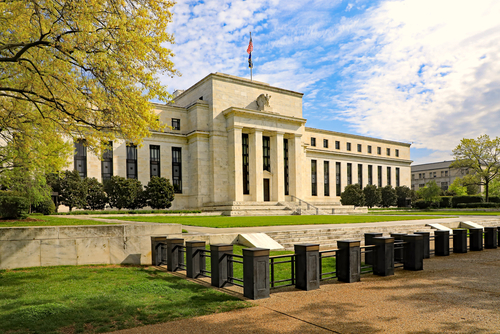

This article is only available to Macro Hive subscribers. Sign-up to receive world-class macro analysis with a daily curated newsletter, podcast, original content from award-winning researchers, cross market strategy, equity insights, trade ideas, crypto flow frameworks, academic paper summaries, explanation and analysis of market-moving events, community investor chat room, and more.
Summary
- A US recession is likely unless the Trump administration moves towards sustainable and predictable tariff policies.
- The tariffs will lift the price level by at least 1ppt while the long-term impact on inflation is uncertain.
- The Fed is likely to cut by about 150bp as the recession will reduce the long-term impact of tariffs on inflation.
- Because of high inflation, the Fed can ease without using quantitative easing (QE) but bond market instability could still see the central bank having to purchase Treasuries.
Market Implications
- I expect about six cuts in 2025 against market pricing 3.5.
Recession More Likely Than Not
A recession is now my base case scenario as:
- Uncertainty has surged to such a high level it has triggered a decrease in private sector spending that is likely to become self-reinforcing (Charts 1, 2, and 3). Due to the loss of confidence, the household savings rate has already increased sharply and, with uncertainty still rising, is set to rise further.
- As of 14 April, the average effective tariff is about 25%, up from 2% in 2024. I expect this will detract more than 1ppt from household real income, another hit to consumption that represents 70% of GDP.
A manufacturing recession is likely as manufacturing will likely to be hit by both an increase in the cost and a shortage of imported inputs. The latter is likely given the complexity and unpredictability of the administration’s tariff policies.
Recent hard data on consumption and investment does not yet show the full impact of the uncertainty due to the frontrunning of tariffs (Chart 4). As a result, increased spending on goods has boosted consumption numbers, though services spending has started to contract (Chart 5).
Similarly, businesses bringing forward imports of equipment goods and industrial supplies is boosting capex indicators. Though eventually goods consumption and business spending will normalize and future weaknesses will offset current strength.
The tariff frontrunning can be seen in the Atlanta Fed GDP nowcast, which now predicts negative Q1 growth due to a large negative contribution of net exports (Chart 6). A large positive contribution in Q2 or Q3 is likely to offset this, so the better indicator of GDP trends is final sales to domestic purchasers (i.e., GDP ex net exports and inventories). The nowcast currently sees final sales at 2% QoQ SAAR, down from actual 3% in Q4. If my predictions are correct, final sales will turn negative in Q1 or Q2.
Demand weaknesses are likely to turn self-reinforcing once they hit the labour market, with slower growth in employment and real wages lowering real household income growth and, in turn, demand for US goods and services (Charts 7 and 8). This has not happened yet but I expect the labour market data to start weakening within the next couple of months.
If the administration moves towards tariff policies that are more sustainable and predictable, the Q1 demand weaknesses we are seeing will likely self-correct and a recession will be avoided, though that is not my base case scenario.
Uncertain Long-term Tariff Impact on Inflation
Short term, the tariffs will lift the price level but their long-term effect on inflation is uncertain. Before the tariffs, inflation was stable and above target, with core goods prices steadily moving out of deflation (Chart 9).
The short-term impact of the tariffs on the price level depends on the dollar and on whether intermediaries (i.e., exporters, importers, wholesalers, and retailers ‘eat up’ some of the increases (Chart 10).
We expect the dollar to weaken further, which could add to imported inflation though the impact could be small as a large share of global trade is invoiced in dollars.
The reaction of intermediaries is likely to be a more important driver of consumer prices. For instance, with the import share of consumption around 10%, if intermediaries absorb half of the tariff increase, the price level could rise by about 1ppt. This excludes the impact of the likely goods shortages on inflation.
Early signs exist that some of the tariff increases are being absorbed through margin compression. For instance, below expectations March PPI, partly due to a decline in trade margins and the below expectations March import prices (Chart 11).
Also, energy prices have been falling which, if sustained, could partly offset tariff increases and stabilize inflation expectations (Chart 12).
Longer term, the impact of tariffs on inflation will depend on businesses pricing power that, in turn, is driven by growth and economic slack.
Meanwhile, 5y5y Bes (Fed’s preferred indicator of long-term inflation expectations) has remained stable (Chart 13). By contrast, short-term BEs and survey-based expectations have been rising (Chart 14).
Fed to Cut 150bp
The Fed is now facing a rare trade-off between its employment and inflation mandates. In addition, the much higher than expected tariff increases have rendered the March SEP obsolete (Table 1).
In his latest speech on 4 April, Chair Powell explained how the Fed would adjudicate between its two mandates. He stated that that the Fed’s overarching objective was to keep long-term inflation expectations well anchored and ‘to make certain that a one-time increase in the price level does not become an ongoing inflation problem.’
FOMC members have expressed similar views, with Governor Waller somewhat more confident that the tariffs would not have second-round effects (Table 3).
I still expect the Fed to cut 150bp, mostly in 2025 (Chart 15). This is because long-term BEs seem stable and because the second-round effects from the tariffs will be driven by businesses’ pricing power. In turn, economy-wide pricing power is driven by economic slack. Therefore, I expect the recession is likely to dampen second-round effects and allow the Fed to cut. With a deeper/shallower downturn, the Fed would cut more/less (Table 2). The 150bps cuts in my base case scenario are based on the 2000s experience.
Also, because the Fed is concerned about risks of second round effects, it is likely to be reactive rather than proactive and may not start cutting until there are clear signs of an economic downturn. In my base case scenario, this would be around mid-year. Once the Fed starts cutting, as Cleveland Fed President Hammack stated, ‘it may move much more quickly’. Based on the recession starting in Q1 or Q2 and lasting about three quarters, I expect most of my 150bp cuts to happen in 2025.
In addition, I expect that, because of higher inflation, the Fed will not hit the zero bound on the policy rate and therefore will not have to use QE to provide policy easing to the real economy. It could still engage in bond purchases if the Treasury market experienced stresses, as it did in the early stages of the pandemic. This is more of a low risk than a tail event as the Treasury market seems to have lost its safe haven status (Chart 16).
Lastly, as I flagged last month, risk exists that the Fed’s balance sheet could already be too small. Stresses in money markets could see the Fed having to end quantitative tightening (QT) and restart QE. This is more of a medium-term risk so long as the debt ceiling is binding, there is no net issuance, and the running down of the TGA is injecting liquidity in the banking system (Charts 17 and 18). Debt ceiling resolution is unlikely until mid-year.
Market Consequences
I expect about six cuts in 2025 against market pricing 3.5.
(The commentary contained in the above article does not constitute an offer or a solicitation, or a recommendation to implement or liquidate an investment or to carry out any other transaction. It should not be used as a basis for any investment decision or other decision. Any investment decision should be based on appropriate professional advice specific to your needs. You are not permitted to publish, transmit, or otherwise reproduce this information, in whole or in part, in any format to any third party without the express written consent of Macro Hive. This includes providing or reproducing this information, in whole or in part, as a prompt.)
